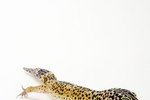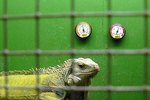Not either being toads -- they’re lizards -- or having actual horns, horned toads have a pretty deceptive name. The term refers to the genus Phrynosoma, a group of relatively small, squat lizards endemic to the Americas. A few species sometimes appear in the pet trade, although they aren’t the easiest of reptiles to maintain and not recommended for the inexperienced. In fact, they can’t really be regarded as pets at all, being only suitable for experienced and dedicated hobbyists.
Background
Horned toads occupy harsh desert environments, to which they are well adapted. Coping with extremes of climate, a scarcity of prey and extremely hungry predators is the reason for this group’s sometimes bizarre characteristics, including their spines and often skittish nature. They are usually solitary except during the breeding season.
Tank Set-Up
In captivity, the tank set-up must mimic the natural environment as closely as possible. The specifics vary by species, but generally you need a warm tank with a temperature drop at night, low humidity and plenty of hiding places. Use sand, preferably with a variety of grain sizes, as the substrate for most species and include a flat rock underneath the basking lamp. Certain species, for example the giant horned lizard (Phrynosoma asio), also appreciate twigs or safe plants, such as grasses, for climbing.
Diet
Horned toads eat a diet similar to many other lizards -- think small invertebrates. Phrynosoma species, however, tend to have pretty specialized nutrition needs, with ants in particular often featuring highly on the menu. A diet consisting entirely of live crickets might be cheap but it isn't suitable. Research the exact needs of your species and ensure you can provide an adequate supply of the right foods, which might mean buying from specialist suppliers.
Considerations
These lizards seem to become stressed easily by even the most careful handling, so avoid touching or picking them up unless essential. Also, avoid startling them, for example by making loud noises or sudden movements near the tank. The timid nature of most horned toads is one of several reasons they are not suitable pets for households with children. Currently, no Phrynosoma species is in imminent danger of extinction, but they are not particularly abundant and populations of a couple varieties are decreasing, which is one reason to avoid purchasing wild-caught lizards.
References
Writer Bio
Judith Willson has been writing since 2009, specializing in environmental and scientific topics. She has written content for school websites and worked for a Glasgow newspaper. Willson has a Master of Arts in English from the University of Aberdeen, Scotland.




